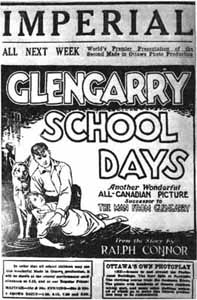"Ten Percent Ernie"
by Joel H. Zemel ©1997-2009
(continued)
In an agreement signed and dated November 1, 1918, Ernest made his best deal to date. James Oliver Curwood agreed to give exclusive film rights to his stories to Nell Shipman for two years while she agreed to star in films based exclusively on his stories. Ernest was co-signatory. The first film was based on Wapi the Walrus, an outdoors melodrama set in the Canadian north with Nell as the lead protagonist. Ernest went to Calgary, Alberta to raise the money. Canadian Photoplays Ltd. was incorporated on February 7, 1919 and filming began later that year. Nell wrote the screenplay which was retitled Back To God's Country.
Despite enormous hardships such as the frigid temperatures, the loss of the Australian lead actor, Ronald William Byram, to pneumonia and grueling living conditions, the film finished production in May after having moved from Lesser Slave Lake in Alberta to southern California. In September 1919, Associated First National released the picture to rave reviews. Ernest's promotional campaign was extensive. It relied heavily on Nell's very brief nude scene which was evident in the advertised drawings and slogans. The film made a 300% profit on its initial investment of $67,000 and was shown all over the world.
For the next four years, Ernest travelled across Canada attempting to repeat the success of Back To God's Country. Nell and Ernest were separated and subsequently divorced in 1920. Curwood broke his contract possibly because of Nell's changing to his original story to accommodate her screenplay. The next two films by Curwood's company, Nomads of the North (1920) and The Golden Snare (1921) were sold and publicized by Ernest, but the financially successful Canadian Photoplays went into voluntary liquidation.
 Poster for "Glengarry School Days" |
Ernest moved his operation to New York and then began filming the novels of Ralph Connor (a.k.a. Charles W. Gordon). The first was The Foreigner later retitled God's Crucible (1921) and Cameron of the Royal Mounted (1922). Both were supposed to be released by First National which according to Ernest had committed to the deal but this was not so. |
With the passing of Ernest Shipman, the age of Canadian independent filmmaking was truly over.
- March 1923 - Address to the Canadian Club in London, Ontario.
Sources:
Embattled Shadows - A History of Canadian Cinema 1895 - 1939 by Peter Morris - McGill-Queen's University Press.
Canadian Film by David Clandsfield - Oxford Press.